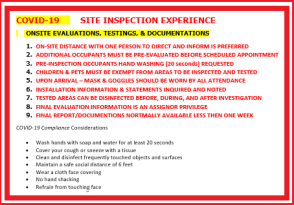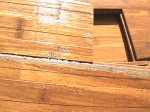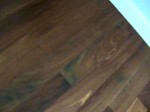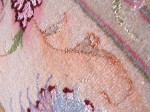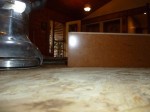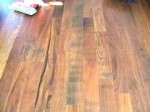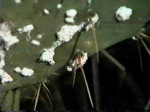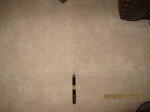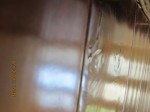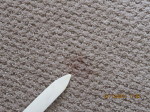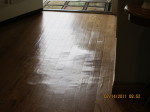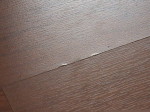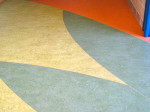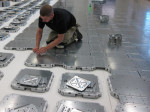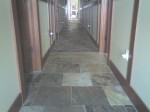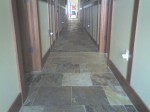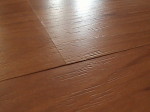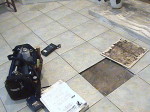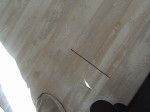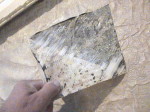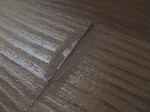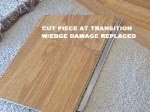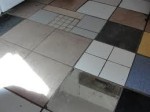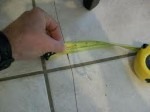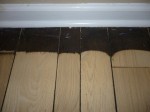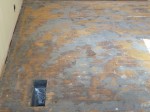"The House Eating
Fungus"
MERULIPORIA INCRASSATA
COMMONLY KNOWN AS PORIA
The following is some information on this structure damaging macro-fungi to date (May 1, 2001).
In the last 2 decades Meruliporia incrassata, sp., an orange colored mushroom shaped macro fungus, with the appearance of pancake batter, has shown up recently in homes from San Diego to northern California. However, poria incrassata, the water-conducting fungus occurs mainly in the southern states, it can be found anywhere. In the past, reports of poria was confined mainly to the Gulf states Miss, Al, Tx, etc.
"It's a rare fungus, but it's as common here as anywhere in the world," said UC Riverside plant pathology professor John Menge. "It's also the most devastating wood-decaying fungus of houses that we know of".
Poria is one of many wood decay fungi that feeds on dead wood. It sounds like science fiction and looks like it too, but poria, like all decay fungi, is an organism that needs moisture to break down and utilize wood as a food source, according to forest product experts at UC Berkeley. But unlike other wood-decaying fungi, which tend to destroy only a six inch area around a plumbing leak or wet window sill, poria has the capacity to begin in wet soil as opposed to just damp soil.
Experts say this water-conducting fungi differs from most other wood decay fungi in several respects: Large, semi-tough water-conducting roots called rhizomorphs are formed which transport water by capillary action from a constant source (usually damp or wet soil) to dry wood in a building, wetting it sufficiently to support decay. As decay proceeds, water is conducted to dry wood adjacent to that already colonized fungi. In this manner, as long as the supply of water is available, water-conducting fungi can colonize and decay the wood to the entire structure. "In other words, because fungus does not have teeth to help it eat, it has to spit on the wood. And the enzyme it secretes turns the wood to mush. Any piece of wood exposed to this fungus is destroyed" says poria expert Glenn Sigmon.
We used to think poria would usually start under a newly installed patio, with new landscaping or with a new room addition, and can travel far from its original water source. But that is not always the case. Wayne Wilcox, a UC Berkeley forestry professor, has found a similarity among houses with poria and the fact that major landscaping was done within 2 years of poria's onset. He speculates that the soil dumped on these suburban lawns originated in various forests around the world, where poria occurs naturally and helps in the process of decomposition, and he feels poria may have come along for the ride.
Donna Kingwell, a spokeswoman for the California state's Structural Pest Control Board, said "the agency is keenly aware of the potent problems of poria, especially in the southern part of California".
First reports of poria incrassata destruction surfaced in 1913 in the southeastern United States, where forest products were the suspected origin of the fungus-abound. There is no record of the first reported case of poria in California, according to Wayne Wilcox, a UC Berkeley forestry professor, but scientists discovered the telltale spores on three coastal redwoods in 1924. Infestations of poria are rare. Only 15 cases were reported state wide by 1968, according to a U.S. Department of Agriculture study.
"When poria does invade a house, it's almost always catastrophic", said Mississippi State University wood technology professor Terry Amburgey. "The fungus will infiltrate a foundation, wood or concrete, and pretty soon the entire house goes".
Poria has an appetite not only for common construction woods such as oak and pine, but for cedar, redwood, cypress and juniper that are naturally decay-resistant. In addition to attacking most woods classed as naturally decay resistant, laboratory tests show that poria is resistant to many fungicides containing copper. The practical significance of this tolerance is uncertain, but no failures of wood treated with copper fungicides have been reported in buildings to date.
When poria attacks a building, spectacular damage often results once well established it can destroy large areas of floors and walls every year or so. Fortunately, control is relatively simple, i.e. the permanent elimination of the water source. Although poria is relatively rare, the rapid and extensive damage it can cause makes it desirable to understand the conditions leading to the attract, the signs indicating an attack is in progress, and methods of prevention and control of an attack.
Control
and Remediation
"The bad news about poria is that it's hidden and it spreads fast, but once you find it, it can be controlled," said Wayne Wilcox.
Earlier control recommendations called for the removal of decayed wood and all sound wood within 2 feet of obvious visible growth on the assumption that poria, once established, can decay wood with metabolic water as the sole source of moisture.
Poria Incrassata is more sensitive to higher temperatures than most decaying fungi and is killed in moist wood at temperatures only moderately above "air-temperature maxima". This explains why poria occurs in the more protected parts of structure and not in wood exposed to full sun. In other words, poria is extremely sensitive to drying. In naturally infected wood, it can survive only 32 days of air drying. In laboratory tests, all artificial infections were dead in 1 day at 10% RH (relative humidity), 5 days at 65%, and 10 days at 90%. Sensitivity to drying, in conjunction with the need for conducted-water, forms the basis for the presently recommended simplified control and remediation measures.
Below are a couple of pictures of a project before and after demolition started
WD-40
Subject: WD-40
WD-40. Who knew?
Painted red all around a beige truck and WD-40 cleaned it all off.
It removed the unwanted paint beautifully.
The product began from a search for a rust preventative solvent and
degreaser to protect missile parts. WD-40 was created in 1953 by three technicians at the San Diego Rocket Chemical Company. Its name comes from the project 'Water Displacement #40' that was to find a 'water displacement' compound. They were successful with the fortieth formulation, thus WD-40. The Corvair Company bought it in bulk to protect their atlas missile parts.
Ken East (one of the original founders) says there is nothing in WD-40 that would hurt you.
Clean the 'shower door', try it. It's the first thing that has ever cleaned that spotty shower door. If yours is plastic, it works just as well as glass. Try it on your stovetop ... Viola!
It's now shinier than it's ever been. You'll be amazed.
Here are some other uses:
1. Protects silver from tarnishing.
2. Removes road tar and grime from cars.
3. Cleans and lubricates guitar strings.
4. Gives floors that 'just-waxed' sheen without making them slippery.
5. Keeps flies off cows.
6. Restores and cleans chalkboards.
7. Removes lipstick stains.
8. Loosens stubborn zippers.
9. Untangles jewelry chains.
10. Removes stains from stainless steel sinks.
11. Removes dirt and grime from the barbecue grill.
12. Keeps ceramic/terra cotta garden pots from oxidizing.
13. Removes tomato stains from clothing.
14. Keeps glass shower doors free of water spots.
15. Camouflages scratches in ceramic and marble floors.
16. Keeps scissors working smoothly.
17. Lubricates noisy door hinges on vehicles and doors in homes.
18. It removes black scuff marks from the kitchen floor!
20. Use WD-40 for those nasty tar and scuff marks on flooring.
It doesn't seem to harm the finish and you won't have to scrub nearly
as hard to get them off. Just remember to open some windows if you
have a lot of marks.
20. Bug guts will eat away the finish on your car if not removed quickly!
21. Gives a children's playground gym slide a shine for a super fast
slide.
22. Lubricates gear shift and mower deck lever for ease of handling on
riding mowers.
23. Rids kids rocking chairs and swings of squeaky noises.
24. Lubricates tracks in sticking home windows.
25. Spraying an umbrella stem makes it easier to open and close.
26. Restores and cleans padded leather dashboards in vehicles and shines
vinyl bumpers.
27. Restores and cleans roof racks on vehicles.
28. Lubricates and stops squeaks in electric fans.
29. Lubricates wheel sprockets on tricycles, wagons, and bicycles.
30. Lubricates fan belts on washers and dryers.
31. Keeps rust from forming on saws and saw blades, and other tools.
32. Removes splattered grease on stove .
33. Keeps bathroom mirror from fogging.
34. Lubricates prosthetic limbs.
35. Keeps pigeons off the balcony (they hate the smell).
36. Removes all traces of duct tape.
37. Spray it on their arms, hands, and knees to relieve arthritis pain.
38. In Florida its used to clean off love bugs from grill and bumpers.
39. In New York, WD-40 protects the Statue of Liberty from the elements.
40. WD-40 attracts fish. Spray a little on live bait or lures.
41. For fire ant bites it takes the sting away and stops the itch.
42. WD-40 is great for removing crayon from walls.
43. If washed and dried a tube of lipstick with a load of laundry,
saturate the lipstick spots with WD-40 and rewash.
44. If you sprayed WD-40 on the distributor cap, it would displace the
moisture and allow the car to start.
45. Removes pricing labels adhesive, and tape adhesives.
46. Remove wood stain from carpet.
The basic ingredient is FISH OIL.






